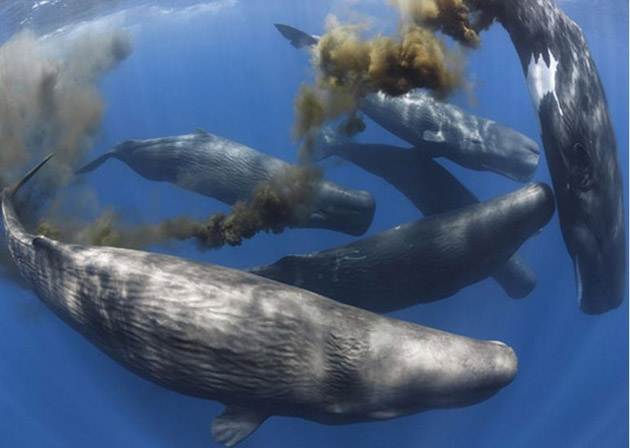
鲸鱼便便带动元素循环
Whale Poop Drives Global Nutrient Cycling
鲸鱼便便带动元素循环
Whales fertilize ocean surface waters with key nutrients like phosphorus, which move through the food chain, and eventually, onto land. Christopher Intagliata reports
通过排泄,鲸鱼将磷等重要营养素从海底带到海面上,通过食物链,这些营养素最终被带往陆地。
撰文/播音 Christopher Intagliata
翻译 M
审校 王娇娇
The world's oceans were once home to 10 times as many whales… before the Captain Ahabs of the world came round. Hunting hit big species the hardest, wiping out 99 percent of the Southern Hemisphere's blue whales, for example. And as the gentle giants disappeared… so did another lesser known element of the oceans: their poop.
曾经,大洋中居住着10倍于现今数量的鲸鱼。直到哈伯船长们(小说《白鲸》的主人公,贪得无厌的猎鲸者)周游世界,奋力猎击——打个比方——消灭了南半球99%的蓝鲸。随着这些温和的巨物消失,另一个鲜为人知的东西也同样消失了:它们的排泄物。
"I've described it as, sort of like oversteeped green tea. Like well steeped green tea. So it's very diffuse, in a big plume." Joe Roman, a conservation biologist at the University of Vermont. "My daughter's friends say I'm a whale poop scientist." And he says, he studies all kinds. "When whales are feeding on krill, they're really high lipids, lots of fat, so it sort of clumps together and floats at the surface. So there's a great variety of fecal plumes out there in the oceans."
“我把它形容为,泡过头的茶叶,或者泡得恰到好处的茶叶。它们极其分散,像一束羽毛。”来自佛蒙特大学的保育生物学家乔?罗马说道,“我女儿的朋友说我是‘鲸鱼便便专家’。”——他关于鲸鱼的研究非常多样。“鲸鱼吃掉了磷虾,这使得他们的粪便富含脂肪和脂类物质,粪便聚集后浮到海面上。因此海里有各种各样的羽状排泄物。”
Whale poop is important because it transports nutrients from the deep ocean, up to the surface. "Sperm whales feed on giant squid and other deep sea creatures. So they'll dive more than a kilometer down." Then they come to the surface to breathe, and digest, "and as it turns out they poop and they also pee. So they're releasing all these nutrients." Nutrients like phosphorous, which are slurped up by phytoplankton and algae. "Which is in turn is consumed by zooplankton, copepods or krill. And those are either eaten by fish or they can be eaten by seabirds."
鲸鱼粪便相当重要,正是它将深海中的营养成分运输到海面上。“抹香鲸以章鱼等深海动物为食。因此它们会下潜到千米的海底。”之后它们浮到海面,进行呼吸和消化。“我们发现它们在海洋表面排泄。这时它们把来自海底的营养物质带到了表层。”浮游植物和藻类吸收了排泄物中磷等营养物质。“它们又被浮游动物、桡足类动物和磷虾等摄食。然后这些小动物再被鱼类或海鸟吃掉。”
Some fish swim up rivers and die; birds sprinkle the land with their guano; and those deep-sea nutrients slowly work their way into ecosystems on land with the help of bald eagles and bears and the like.
鱼类回游到河流并死亡,鸟类把粪便洒向陆地,那些来自深海的营养物质,在秃鹰和熊等动物的帮助下,缓慢地流入陆地生态系统。
Roman and his colleagues modeled how that conveyer belt of nutrients has slowed due to the huge declines in whale, seabird and fish populations. And they reckon that only a quarter as much phosphorus makes it to surface waters today compared with the past. And the flow of phosphorus to land has nearly stopped--at just 4 percent of historic levels. The results are in the Proceedings of the National Academy of Sciences. [Christopher E. Doughty et al, Global nutrient transport in a world of giants]
罗马和他的同事建模计算了鲸鱼、鱼类和海鸟数量的减少对深海营养运输的减缓作用。他们发现,相比于过去,只有四分之一的磷元素从海底转移到海面。而从海洋到陆地的磷元素流动几乎停止——仅有历史水平的4%。相关研究结果发表在了《美国国家科学院院刊》(the Proceedings of the National Academy of Sciences)。
Roman says this slowing of the nutrient conveyer belt is reversible, though. "The most important part for me is trying to restore these species as ecological engineers on the planet, and really try and share the planet with them. Let's not just keep them in zoos or even in small island pockets of protected areas. Let's let them move around the planet more freely." And when they do, he says… those key nutrients, too, will once again roam the Earth.
罗马说,尽管元素传输带的减慢是可逆的。“但作为生态工程师,对我而言最重要的是尝试恢复这些种群,并与它们共享这颗星球。让我们不要仅仅把它们关在动物园或者小小的岛域保护区内,让它们在全球范围内自由活动。” 他说,如果它们能自由活动,同样地,那些重要的元素会再次在地球上自由流动。
未经书面许可任何人不得复制或镜像
京ICP备11000850号-1
 京公网安备11010502039775号
京公网安备11010502039775号 信息网络传播视听节目许可证0111611号
国家科技基础条件平台

















